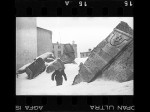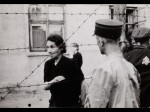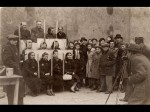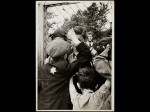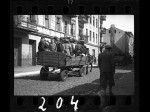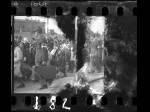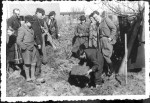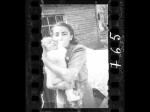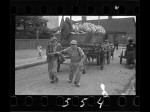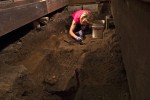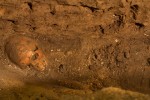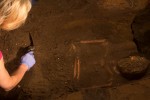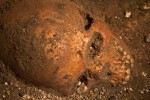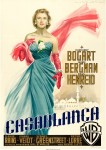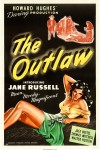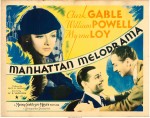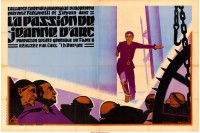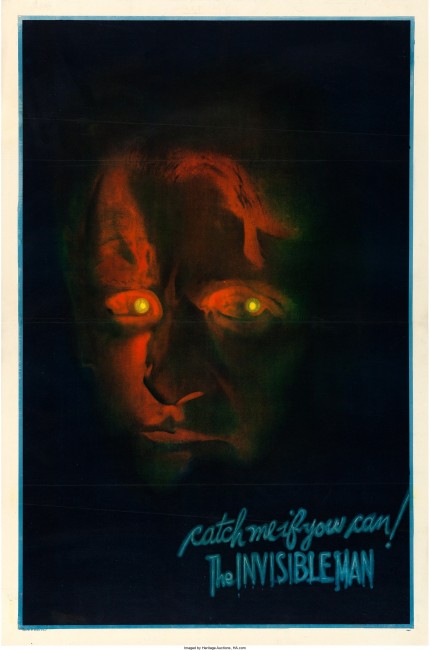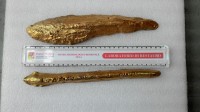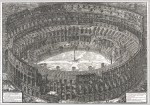 The Colosseum is the most visited monument in the world today. The great amphitheater built in Rome during the reigns of the Flavian dynasty emperors Vespasian and Titus (72-80 A.D.) is an icon of ancient Roman engineering and bloodlust, but it has outlived the empire that created it by 1,500 years. The Colosseum saw many changes in its long post-antiquity lifespan, its architecture altered by activity both human and seismic, dedicated to a wide variety of uses from cemetery to shopping mall to fortress. That rich later history is overshadowed by its ancient resume, and the millions of tourists who flock to the Colosseum every year hear a lot more about the gladiatorial combat of the 1st century than about the butchers’ stalls of the 11th.
The Colosseum is the most visited monument in the world today. The great amphitheater built in Rome during the reigns of the Flavian dynasty emperors Vespasian and Titus (72-80 A.D.) is an icon of ancient Roman engineering and bloodlust, but it has outlived the empire that created it by 1,500 years. The Colosseum saw many changes in its long post-antiquity lifespan, its architecture altered by activity both human and seismic, dedicated to a wide variety of uses from cemetery to shopping mall to fortress. That rich later history is overshadowed by its ancient resume, and the millions of tourists who flock to the Colosseum every year hear a lot more about the gladiatorial combat of the 1st century than about the butchers’ stalls of the 11th.
![]() A new exhibition seeks to correct that oversight. Colosseum. An Icon is the first exhibition to tell the full story of the Flavian Amphitheater, from the gladiators to the butchers and beyond. It covers the numerous attempts at repair and restoration, how the space was repurposed over the centuries, the construction of brick buttresses in the 19th century to keep the outer walls from collapse, how it became a favorite subject of artists from the Renaissance through the Grand Tour era, launching it as the iconic representation of the city of Rome and ancient Roman grandeur. That image spread even wider when moneyed travelers brought back fine marble miniatures and micromosaics of the Colosseum as souvenirs in the 19th century.
A new exhibition seeks to correct that oversight. Colosseum. An Icon is the first exhibition to tell the full story of the Flavian Amphitheater, from the gladiators to the butchers and beyond. It covers the numerous attempts at repair and restoration, how the space was repurposed over the centuries, the construction of brick buttresses in the 19th century to keep the outer walls from collapse, how it became a favorite subject of artists from the Renaissance through the Grand Tour era, launching it as the iconic representation of the city of Rome and ancient Roman grandeur. That image spread even wider when moneyed travelers brought back fine marble miniatures and micromosaics of the Colosseum as souvenirs in the 19th century.
 The exhibition also illustrates the profound shift in attitude towards the amphitheater from Christians in general and the Papacy in particular. The last recorded games were held in 523 A.D., an animal hunt celebrating the consulship of Anicius Maximus, and already then the Colosseum was very much reduced. The top gallery had collapsed, entrances were impassable, the hypogeum flooded. Neglect, earthquakes and the failure of the unmaintained drainage system took an enormous toll on the building. Travel writers in the Middle Ages thought it was some sort of pagan temple and associated it with nefarious demonic goings-on.
The exhibition also illustrates the profound shift in attitude towards the amphitheater from Christians in general and the Papacy in particular. The last recorded games were held in 523 A.D., an animal hunt celebrating the consulship of Anicius Maximus, and already then the Colosseum was very much reduced. The top gallery had collapsed, entrances were impassable, the hypogeum flooded. Neglect, earthquakes and the failure of the unmaintained drainage system took an enormous toll on the building. Travel writers in the Middle Ages thought it was some sort of pagan temple and associated it with nefarious demonic goings-on.
That demon-haunted reputation clung to the Colosseum well into the Renaissance. Renown goldsmith Benvenuto Cellini had a raucously occult experience at the amphitheater in the 1530s which he recounts in his memoirs.
We went together to the Coliseum; and there the priest, having arrayed himself in necromancer’s robes, began to describe circles on the earth with the finest ceremonies that can be imagined. I must say that he had made us bring precious perfumes and fire, and also drugs of fetid odour. When the preliminaries were completed, he made the entrance into the circle; and taking us by the hand, introduced us one by one inside it. Then he assigned our several functions; to the necromancer, his comrade, he gave the pentacle to hold; the other two of us had to look after the fire and the perfumes; and then he began his incantations. This lasted more than an hour and a half; when several legions appeared, and the Coliseum was all full of devils.
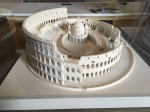 As late as 1594, the Popes were still renting the Colosseum out to glue makers and contemplating converting the whole structure into a factory with residences for the workers in the top galleries. That changed in the Jubilee year of 1675, when Pope Clement X declared the Colosseum a sacred site of martyrdom for all the Christians said to have been condemned to death in the arena. (There is little evidence that Christians were martyred at the Colosseum, btw, and the stories of martyrdom in the amphitheater only began circulating in the Renaissance.) Clement had ambitious plans to dedicate a church to the martyrs inside the Colosseum, asking the great polymath Gianlorenzo Bernini to design it. It was too expensive, though, so Clement just had a cross installed in the arena instead.
As late as 1594, the Popes were still renting the Colosseum out to glue makers and contemplating converting the whole structure into a factory with residences for the workers in the top galleries. That changed in the Jubilee year of 1675, when Pope Clement X declared the Colosseum a sacred site of martyrdom for all the Christians said to have been condemned to death in the arena. (There is little evidence that Christians were martyred at the Colosseum, btw, and the stories of martyrdom in the amphitheater only began circulating in the Renaissance.) Clement had ambitious plans to dedicate a church to the martyrs inside the Colosseum, asking the great polymath Gianlorenzo Bernini to design it. It was too expensive, though, so Clement just had a cross installed in the arena instead.
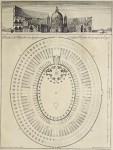 The idea didn’t die with him. Twenty years later, architect Carlo Fontana was enlisted to design a prospective Church of the Holy Martyrs inside the Colosseum. Again, the church never happened, but he studied the amphitheater in great detail for this project and wrote a book about its architecture, ancient history, current condition and the proposed church that was published posthumously in 1725. (Random History Blog connection: Fontana’s original architectural drawing of the church in the Colosseum is in the collection of the wonderful Sir John Sloane’s Museum in London.) The architectural model and several of Fontana’s drawings are on display in the new exhibition.
The idea didn’t die with him. Twenty years later, architect Carlo Fontana was enlisted to design a prospective Church of the Holy Martyrs inside the Colosseum. Again, the church never happened, but he studied the amphitheater in great detail for this project and wrote a book about its architecture, ancient history, current condition and the proposed church that was published posthumously in 1725. (Random History Blog connection: Fontana’s original architectural drawing of the church in the Colosseum is in the collection of the wonderful Sir John Sloane’s Museum in London.) The architectural model and several of Fontana’s drawings are on display in the new exhibition.
![]() The major restoration of the Colosseum, which is still ongoing, discovered many objects and remains from its later life which are will be part of the exhibition. An abundance of butchered animal bones and cooking utensils were found, a testament to the butchers, eateries and private residences which rented space in the ground-level vaults through the 12th century. Of course they unearthed ancient sculptures and architectural details galore. They will join one of only two surviving statues of the 160 that adorned the arches of the second and third-floor arcades when the Colosseum was first built.
The major restoration of the Colosseum, which is still ongoing, discovered many objects and remains from its later life which are will be part of the exhibition. An abundance of butchered animal bones and cooking utensils were found, a testament to the butchers, eateries and private residences which rented space in the ground-level vaults through the 12th century. Of course they unearthed ancient sculptures and architectural details galore. They will join one of only two surviving statues of the 160 that adorned the arches of the second and third-floor arcades when the Colosseum was first built.
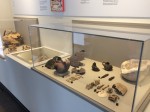 The restoration also discovered traces of the Colosseum’s life as a fortress for the powerful Roman noble Frangipani family. Restorers found holes bored into travertine blocks on the top tier of the southern wall. The holes held beams that supported a wooden walkway used by Frangipani soldiers as a lookout station. The find was announced Monday at the press conference about the new exhibition.
The restoration also discovered traces of the Colosseum’s life as a fortress for the powerful Roman noble Frangipani family. Restorers found holes bored into travertine blocks on the top tier of the southern wall. The holes held beams that supported a wooden walkway used by Frangipani soldiers as a lookout station. The find was announced Monday at the press conference about the new exhibition.
Colosseum. An Icon opens Wednesday, March 8th and runs almost a full year until January 7th, 2018. It’s at the Colosseum, in case that wasn’t clear.
